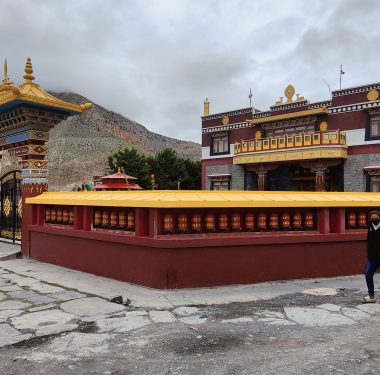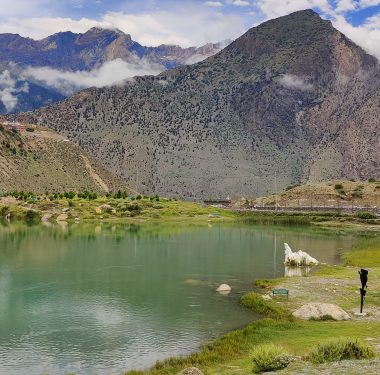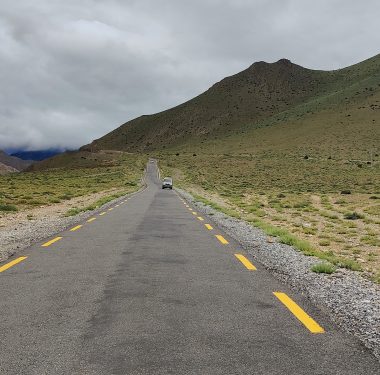Mustang was once an isolated and independent Tibetan kingdom. Today, it is an exotic place in Nepal that still retains a mystical reputation. In an unabated search for villages that still performed the sky burial funerals, we discovered a lot throughout the journey.
Sky burial is an ancient Tibetan funeral which has an unusual yet unique process. The corpse is first dismembered. Then it is exposed on an elevated location, as an offering for the sacred vultures.
Well, a sky burial is far from any other conventional kind of ‘burial’. Only a few cultures observe it — for different reasons and in different ways.
Sky burial can come off as shocking to a lot of people; after all, it’s dead bodies being chopped and offered to vultures. But the philosophy and values behind this ritual are simply beautiful and virtuous. “If your spirit has left your body and it could nourish another creature, then it should.”

The onset of our journey
It started with a short flight to Pokhara, from where we drove for more than 10 hours to Jomsom.
Jomsom is one of the biggest cities in Mustang district, well known for its relentless winds. Connecting Lower Mustang with the Upper, it’s also one of the most popular trekking destinations in Nepal. It’s mostly visited by the majority of people going to the temple of Muktinath as well.
The village close to Jomsom is Kagbeni, which sits at the bottom of Muktinath valley. Kagbeni is famous for people, from all around the country, visiting to perform post-funeral rituals. Yet, this village still has not seen any sky burial for more than a decade.
We then walked for about 45 minutes, crossing the Kali Gandaki river to come upon a small village named Tiri. There we met Chhamba Dukta in Gonpa Gong. He is a Lama who performs sky burials, originally in his village in Dolpa, and in Mustang. He told us that it has been around 10 years since any sky burial. The villagers have settled for easier burning funerals, rather than difficult sky burials.
On his reference, our team headed towards a village, Dhamkar, in Upper Mustang. ‘Dham’ stands for hills and ‘Kar’ stands for red, meaning ‘Red Hills’ in the local language. The lower parts of Mustang have almost shunned the rituals of sky burial. This is mainly because of development of roadways and hiking trails.


The basis for sky burial
The very first thing to do after a person dies is to determine the method for their funeral. Usually, a high priest looks into the time of birth and death to find out what sign the person is. He determines one of the five signs: earth, water, air, sky, and fire through basic astrology. After ascertaining the sign, s/he is either buried, chopped and fed to the fishes, chopped and fed to the vultures or burned respectively.

What exactly happens in a sky burial?
After a Lama determines the process, the body is first tied up and he begins to recite the necessary prayers. Family members join along, beating double-sided drums and chanting prayers. They offer their condolences to the deceased by offering Khada, a religious cloth for farewell. Then, the priest goes around the body thrice, and it’s carried to a place that is specially allocated for the funeral.
Once there, the body breakers chop the body into precise pieces. The tip of the fingers containing the nails are considered to be poisonous to the vultures, so they are burnt along with the head. Once the offerings are ready, the Lama plays Damaru, an instrument crafted from the human knee. This is an invitation for the vultures to glide down and devour the offerings.
It is believed to be a bad omen if the vultures do not feed on the body. It implies that the body is too dirty to eat (ie, the person has sinned), or the rituals weren’t performed correctly. In such a case, the body has to be burnt, which is considered inauspicious, as it had to follow two traditions.
Concepts behind sky burial
As described in the traditional Tibetan mythologies, sky burials signify a true act of compassion and charity. The body, which never again serves any purpose, is offered to the vultures to feed on as an alms for the sacred birds.
So, the idea at work here is that if a body that ideally serves no use can sustain some other creature, then why not? After all, it’s important to not waste any opportunity to help other living beings.
One of the other interesting concepts of sky burial revolves around the choice of the animal: the vultures.
A traditional Tibetan mythology indicates that once the vultures are old, they do not fall back to the earth when their time has come. Rather, they keep flying higher until they just disappear into the sky.
And that’s where the name comes from: Sky Burials!
This unique tradition of sky burials is slowly getting extinct, with lesser to none sky burials performed in a year throughout the country. Well, in Kathmandu Films, we believe that it is our duty to explore and document such an intimidating ritual. And to spread beautiful accounts as such to keep the originality and uniqueness of Nepal alive.





